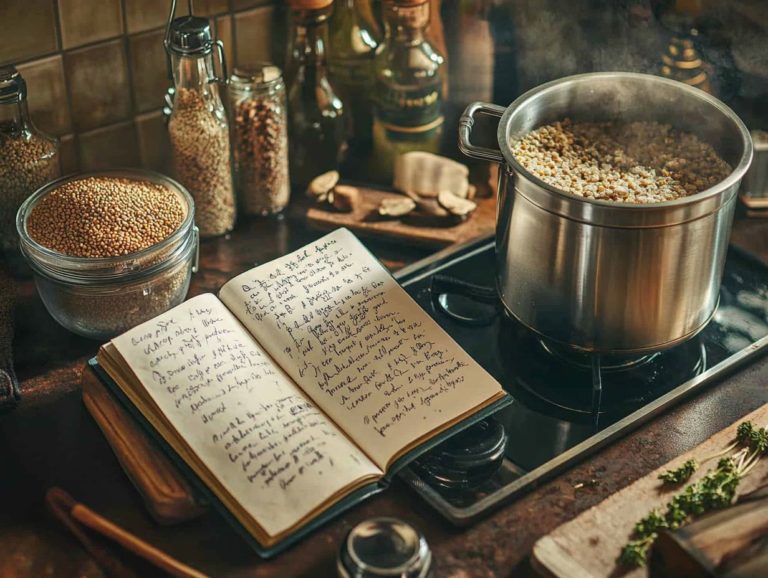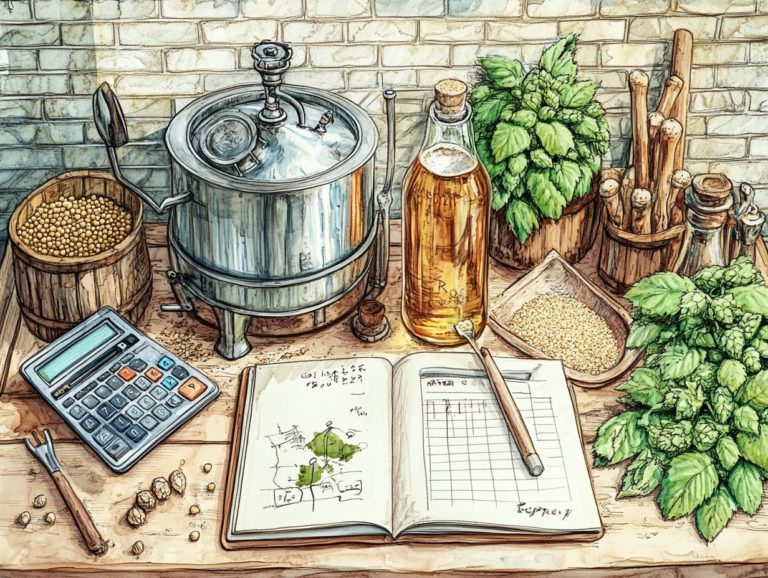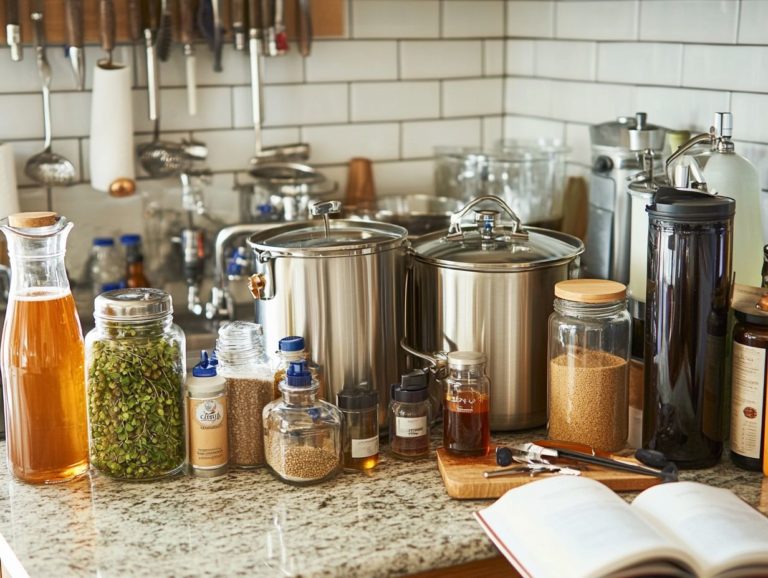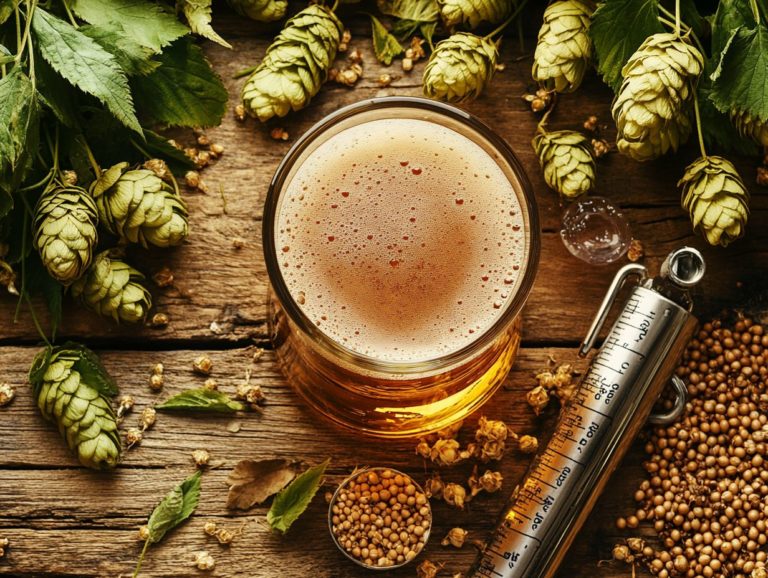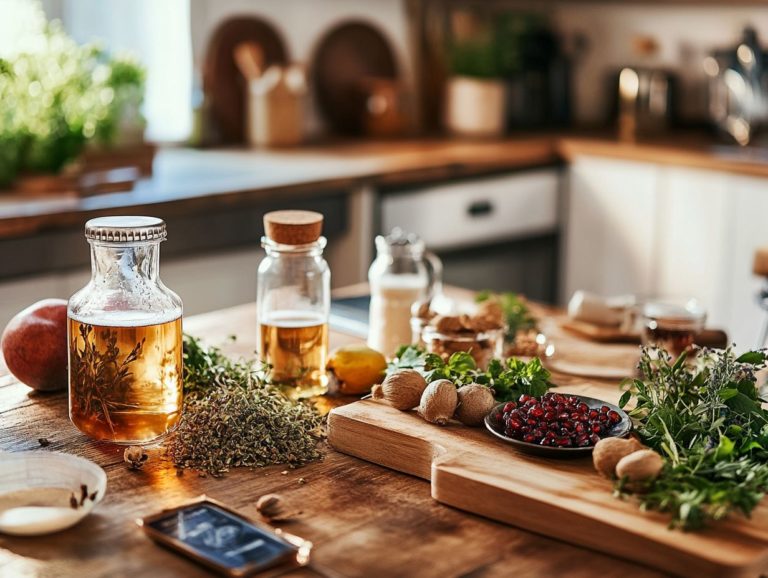How to Use Adjuncts in Home Brewing
Contents
- The Importance of Adjuncts in Home Brewing
- Key Takeaways:
- Why Are Adjuncts Used in Home Brewing?
- What Are the Different Types of Adjuncts Used in Home Brewing?
- How to Use Adjuncts in Your Home Brewing Process?
- What Are Some Tips for Using Adjuncts in Home Brewing?
- Frequently Asked Questions
- What are adjuncts in home brewing and why are they used?
- What are examples of common adjuncts used in home brewing?
- How do I determine how much adjunct to use in my home brew?
- Do adjuncts require any special preparation before adding them to the brewing process?
- Can I use adjuncts in any type of home brew?
- What are some tips for successfully using adjuncts in home brewing?
The Importance of Adjuncts in Home Brewing
Home brewing is an exhilarating journey where your creativity blends seamlessly with craftsmanship. One essential element that can elevate your brews is the use of brewing adjuncts. These additional ingredients ranging from grains to fruits and spices are pivotal in enhancing flavor, improving head retention, and even cutting down costs.
This guide will take you through the various types of adjuncts, offering insights on how to effectively incorporate them into your brewing process. We also provide brewing tips to help you create exceptional beers.
Whether you’re just starting out or have years of brewing experience under your belt, understanding brewing adjuncts can unlock a world of flavor possibilities in your home brewing adventure.
Key Takeaways:
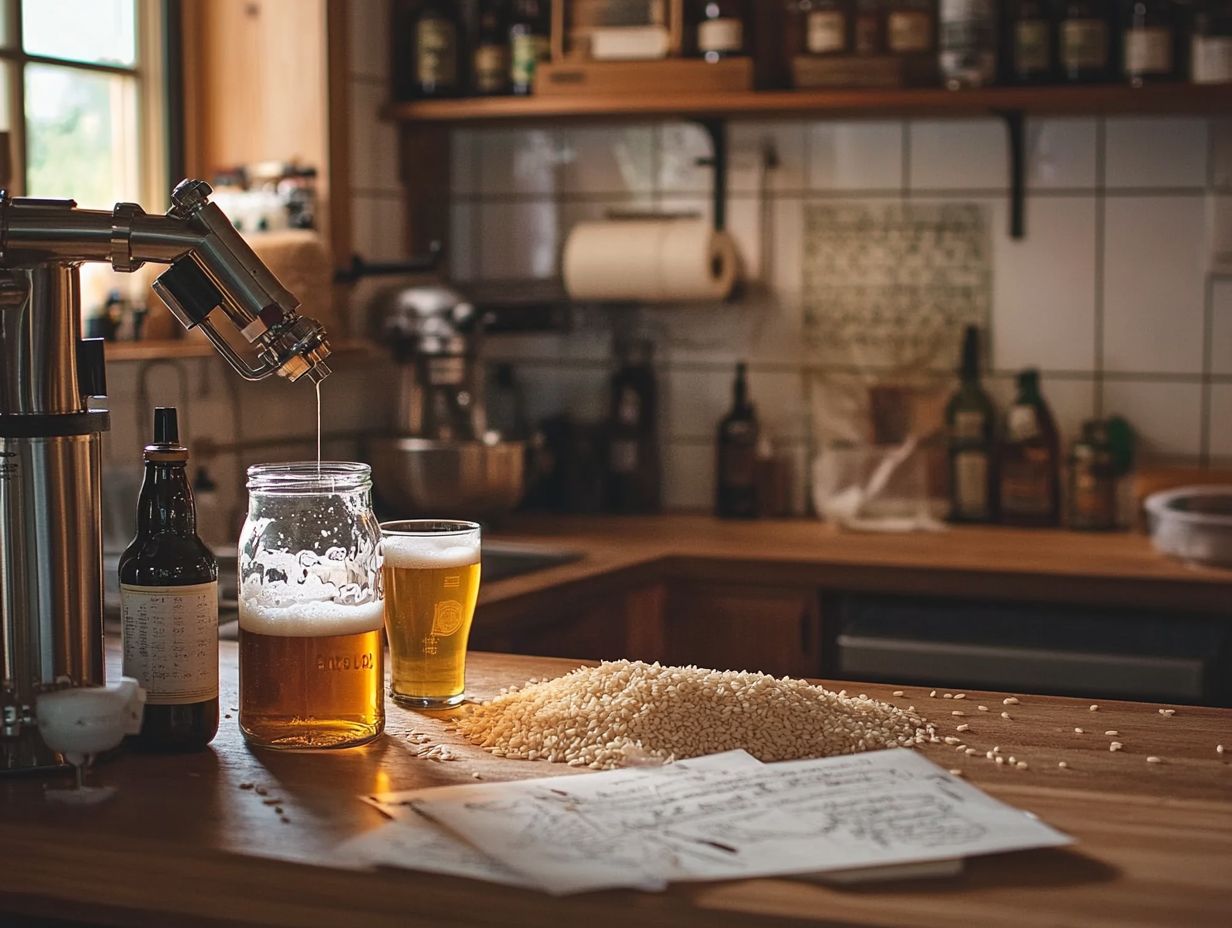
- Experiment with different types of adjuncts to add unique flavors and aromas to your homebrew.
- Carefully consider the amount and timing of adjunct additions to achieve the desired flavor and fermentable sugar levels, ensuring consistency in brewing.
- Adjuncts can be a cost-effective way to enhance your homebrew, but be mindful of their impact on head retention.
Why Are Adjuncts Used in Home Brewing?
Adjuncts serve a vital role in home brewing, elevating the complexity and allure of beer by introducing intriguing flavor combinations and enhancing brewing efficiencies. These adjuncts can range from malted barley to coffee and various fruits, providing you the opportunity to experiment creatively while ensuring consistency in your brewing process.
By skillfully balancing adjuncts with traditional brewing ingredients, both craft breweries and home brewers can significantly enhance the quality of their beer, crafting each batch to be distinct and enjoyable for diverse palates. Gaining a deeper understanding of the purpose behind these adjuncts can truly transform your brewing experience, allowing you to master different brewing techniques from the fermentation process to secondary fermentation.
1. To Add Flavor
One of the primary reasons to use adjuncts in home brewing is to infuse extraordinary flavors that traditional brewing methods simply can t achieve. Think along the lines of popular options like vanilla, chocolate, and coffee each bringing its own unique twist to the brew.
These adjuncts open a world of possibilities, transforming simple brews into complex, flavorful experiences. For instance, when you combine chocolate with coffee, you craft a rich stout that feels like a decadent dessert in a glass. On the other hand, adding citrus peel can brighten up a heavier beer, providing a refreshing contrast that dances on the palate. Why not experiment with a Pi a Colada Glitter Saison for a fun twist?
Techniques such as steeping fruits or spices during fermentation, or using dry hopping which means adding hops after the boiling stage to enhance aroma can significantly enhance these flavor profiles. Careful selection and timing are crucial; adding flavors at different stages can lead to dramatically different outcomes. For example, late hop additions tend to highlight aromatic qualities, while early additions focus on bitterness.
Ultimately, the careful selection and timing of your adjuncts yield a unique beer that showcases your creativity and depth as a brewer.
2. To Add Fermentable Sugars
Adjuncts serve a vital purpose in the brewing process, introducing fermentable sugars that can significantly boost both the efficiency and yield of your beer batch.
These adjuncts think rice, corn, and various grains are essential as they provide additional sugar sources that yeast eagerly convert into alcohol. For example, incorporating rice adjuncts contributes a lighter body to the beer, resulting in a refreshing taste while keeping the calorie count in check. This approach fosters a cleaner fermentation profile and has the potential to elevate the alcohol content without sacrificing the delicate balance of flavors.
By thoughtfully integrating adjuncts, you craft a distinctive final product that appeals to a variety of palate preferences, enhancing the overall drinking experience and attracting a broader audience.
3. To Improve Head Retention
Improving head retention in beer is a vital aspect of utilizing adjuncts, which significantly contribute to the overall characteristics and mouthfeel that you seek.
These adjuncts think oats, wheat, and even certain sugars play a crucial role in crafting that coveted frothy layer atop your glass. When breweries incorporate these ingredients, they not only bolster the stability of the foam but also introduce a creamy texture and nuanced flavors that elevate your drinking experience to new heights. Incorporating brewing sugars correctly can also ensure the desired beer characteristics.
For instance, when you enjoy a hefeweizen with wheat or a hazy IPA featuring oats, you re treated to a luscious mouthfeel that beautifully complements the beer s aromas. Moreover, certain brewing methods, like dry hopping or specialized fermentation techniques, can further enhance these attributes, ensuring that every sip is both pleasurable and unforgettable.
The science behind these adjuncts lies in their protein composition, which interacts with the carbon dioxide during brewing, forming a robust head that lingers invitingly, encouraging you to savor each refreshing taste.
4. To Reduce Costs
Using adjuncts in home brewing presents an excellent opportunity for you to significantly cut costs. By substituting more expensive malted barley with affordable alternatives, you can maintain quality while keeping your expenses in check.
This strategy is especially advantageous if you tend to brew in larger batch sizes, as the savings become even more apparent with increased quantities. Incorporating adjuncts like corn, rice, or oats not only helps you manage your brewing budget but also introduces unique flavor profiles and textures that can elevate your final product.
For home brewers who wish to maintain a cost-effective approach, adhering to strategic brewing guidelines such as fine-tuning mash temperatures and understanding how fermentation works can lead to a more streamlined brew day. By exploring these options, you can optimize your recipes, minimize waste, and fully enjoy your craft without putting a strain on your budget.
What Are the Different Types of Adjuncts Used in Home Brewing?

In home brewing, you have access to a diverse array of adjuncts that can be expertly employed to elevate your brewing styles and techniques. Each adjunct brings its own distinctive characteristics and flavor intensity, allowing you to craft a final product that truly reflects your vision and creativity. From brewing history to innovative recipes, adjuncts offer endless possibilities for creativity in brewing.
1. Types of Grains
Grains are the very foundation of brewing, with malted barley standing out as the most popular choice. You often find rice and wheat adjuncts in light, refreshing beer styles.
But don t overlook the other grains like oats and rye; they have their own important roles to play in the brewing process, each bringing unique flavors and mouthfeel to the table. Oats can add a delightful creaminess and body to stouts and porters, while rye injects a spicy, robust character that shines in specialty ales.
Handling each grain type correctly is crucial. A typical brewing ratio might involve 60-70% base malt, complemented by 10-20% specialty grains to create that added complexity. This careful balancing act during the mash process is essential, as it influences not just the flavor but also the final clarity and color of your beer, resulting in a brew that is both delicious and visually appealing.
Mastering brewing ratios and understanding brewing terminology can significantly improve your brewing experience.
Explore these adjuncts in your next brew and discover the amazing flavors they can bring!
2. Sugars
Sugars are essential for brewing efficiency and play a crucial role in fermentation.
They provide additional fermentable options.
In your home brewing adventures, explore a variety of sugars, each boasting unique characteristics.
Common choices include cane sugar, corn sugar, and honey.
Each contributes distinct flavors and fermentability to your beer.
For instance, cane sugar is favored for its ease of use, while honey adds delightful aromatic qualities and a touch of residual sweetness.
Precision is key, so measuring your sugars accurately perhaps with a digital scale will ensure you achieve the desired outcomes.
Consider when to integrate these sugars into your recipes, whether during the boil or secondary fermentation, as this timing can greatly influence the final flavors and alcohol content of your brew.
Understanding how different brewing temperatures impact sugar fermentation can further fine-tune your beer’s profile.
3. Fruits and Vegetables
Fruits and vegetables can be thrilling accompaniments in your home brewing journey.
They allow you to infuse vibrant flavors like oranges, lemons, and grapefruits into your creations.
By incorporating these natural ingredients, you can elevate your tasting experience.
You introduce unique notes that traditional brewing methods might easily overlook.
Whether it s the zesty brightness from citrus or the delicate sweetness of ripe berries, each ingredient brings its own distinct personality to your final product.
Incorporating fruit adjuncts can lead to exciting new flavor combinations that enhance your brewing adventures.
To effectively extract their flavors, consider techniques such as infusion during fermentation or adding them directly to the boil.
These methods are favorites among brewing aficionados.
It s essential to keep the balance of flavors in mind, ensuring that no single element overshadows the beer s foundation.
This thoughtful approach will ultimately lead to a more harmonious and layered flavor profile in your brew.
4. Herbs and Spices
Herbs and spices create an exciting world of unique flavors in home brewing!
For instance, incorporating ingredients like coriander can achieve a delightful citrusy sweetness.
Meanwhile, chamomile introduces a calming floral note to your brew.
Techniques such as steeping these herbs and spices during the boil or adding them during secondary fermentation can effectively enhance their flavors.
If you re feeling adventurous, experimenting with bolder spices like ginger or cinnamon can infuse warmth and depth, particularly in seasonal recipes.
The key is to strike a balance with these additions.
Ensure that the primary ingredients still take center stage while enriching the overall profile of your brew.
By thoughtfully selecting and incorporating these elements, you can craft distinctive beverages that surprise and delight the palate.
5. Other Flavorings
Plus traditional adjuncts, you have a world of flavoring options at your disposal!
Exploring ingredients like coffee and chocolate can add remarkable depth and complexity to your brew.
For instance, incorporating freshly brewed coffee during the boil or conditioning phase infuses a robust aroma.
It also contributes a rich flavor profile that beautifully complements various styles, from stouts to porters.
Similarly, employing cocoa nibs or chocolate malt introduces decadent, dessert-like qualities to your beer.
It s essential to integrate these adjuncts at different stages of the brewing process.
This ensures that the flavors meld together harmoniously without overshadowing the beer’s base character.
How to Use Adjuncts in Your Home Brewing Process?

Successfully incorporating adjuncts into your home brewing process demands a solid grasp of various brewing techniques and methods.
You must also adhere to specific brewing guidelines to achieve the desired outcomes.
1. Choosing the Right Amount
Selecting the right amount of adjuncts additional ingredients used in brewing to enhance flavor is essential for achieving the perfect flavor balance and maintaining consistency across your brewing batches.
To determine the appropriate quantities, you need to consider your specific batch size and desired brewing ratios. This requires a thoughtful analysis of your ingredients, including base malts and adjuncts, ensuring that every element plays a positive role in the final flavor profile.
Don t underestimate the power of experimentation. Making small adjustments and meticulously documenting your process allows you to refine your technique and enhance flavor extraction.
Over time, you ll cultivate a dependable brewing method that reflects your unique tastes, giving you the power to replicate that ideal brew while still embracing the freedom to innovate and adapt as you wish.
2. Adding During the Mash
Incorporating adjuncts during the mash stage can profoundly influence both the flavor profile and efficiency of your brewing process. By adding ingredients such as corn, rice, or specialty grains, you elevate the complexity of flavors in your final product and optimize fermentation.
For instance, the right adjuncts can promote a more complete fermentation, resulting in a drier finish or a smoother mouthfeel, depending on your choice. Timing is crucial when integrating these adjuncts during mashing; introducing them early maximizes flavor extraction, while adding them later can impart nuanced flavors that truly stand out.
Employing techniques such as maintaining a consistent temperature and adjusting the mash duration will help ensure that your adjuncts reach their full potential, resulting in a tasty and enjoyable drink.
3. Adding During the Boil
Incorporating adjuncts during the boiling phase of brewing can significantly enhance the intensity of flavors and contribute to the overall character of your beer. This stage is particularly crucial for developing the rich tapestry of flavors you desire.
Certain adjuncts, like corn or rice, are often added to lighten the body and create a smoother finish, while sugar additions can elevate alcohol levels without heavily altering the flavor profile.
Specialty grains like crystal malt can introduce delightful caramel and toffee notes, enriching the beer s complexity. Timing is everything when it comes to hops during this stage; the moment you add them directly impacts bitterness, aroma, and flavor extraction.
Employing techniques like late hopping or hop bursting can maximize those aromatic qualities, transforming your brews from ordinary to extraordinary, ultimately captivating the palate and leaving a lasting impression.
4. Adding During Fermentation
The addition of adjuncts during fermentation, particularly in the secondary stage, offers you an opportunity to enhance flavor extraction and achieve a more refined final product.
These adjuncts whether they be fruits, spices, or grains provide unique characteristics that elevate the overall profile of your beer. By introducing these elements at just the right moment, you can influence not only the aroma and taste, but also the color and mouthfeel of the brew.
Timing is everything; for instance, adding fruits during secondary fermentation helps preserve their delicate flavors. Spices often benefit from a brief infusion period.
Don t shy away from experimenting with different integration methods, such as steeping or pureeing your adjuncts. This creative exploration can lead to exciting results, ultimately crafting a more complex and satisfying beer.
5. Adding During Packaging
Incorporating adjuncts during the packaging process can be a game-changer, ensuring powerful flavor extraction and elevating the overall quality of your beer just before the final seal.
This strategic moment opens the door for you to introduce an exciting array of flavors think fruits, spices, or even honey that can completely revamp your beer’s flavor. By employing techniques like infusion or dry-hopping with adjuncts, you enhance the beer’s unique character and diversify its offerings.
This method gives you the power to craft distinct profiles that resonate with craft beer enthusiasts, ensuring that every sip tells a compelling story.
Ultimately, the careful selection and incorporation of adjuncts at this stage can create a memorable drinking experience that truly stands out in a crowded market.
What Are Some Tips for Using Adjuncts in Home Brewing?
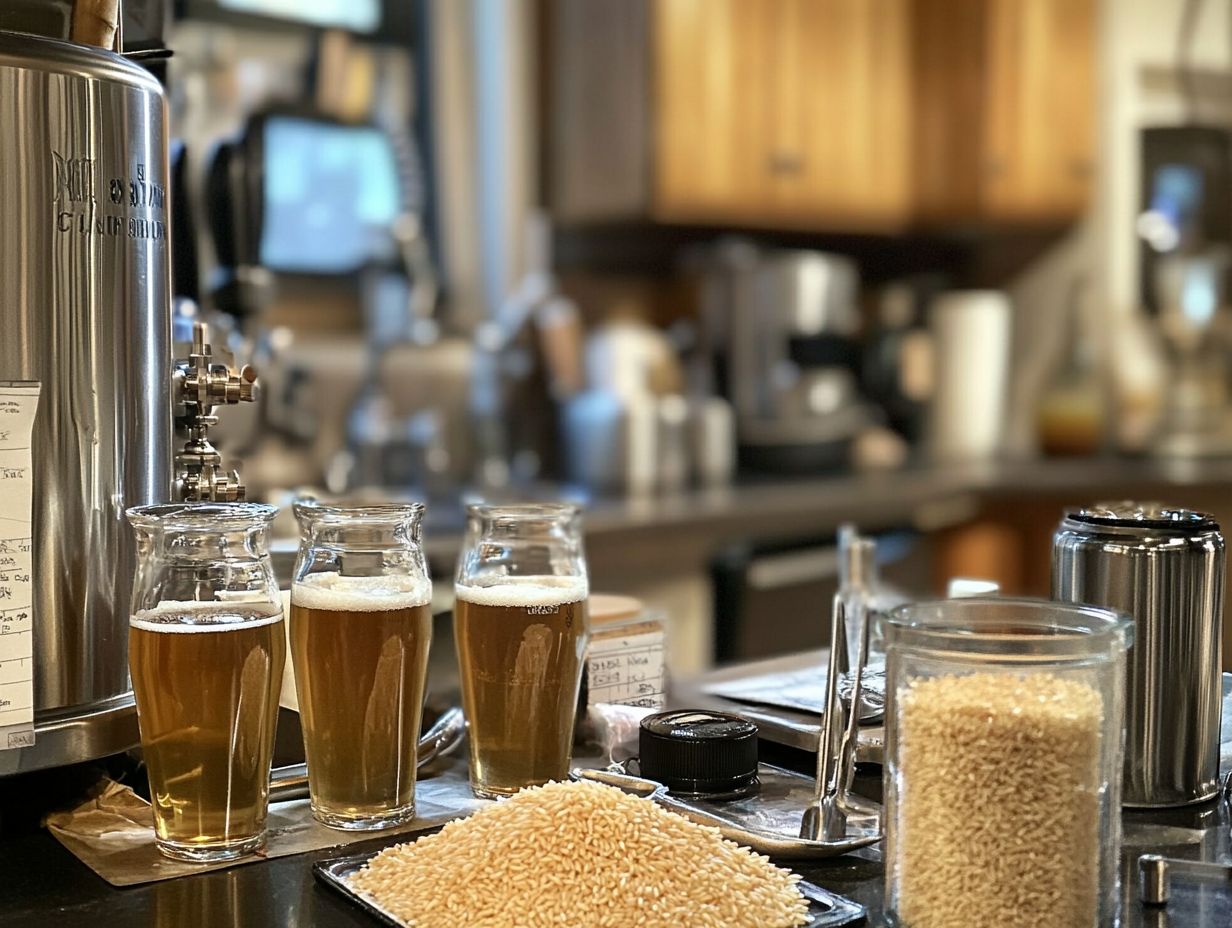
Incorporating adjuncts into your home brewing can present unique challenges. By following a few strategic tips, you can significantly elevate both your brewing experience and the quality of your beer.
Frequently Asked Questions
What are adjuncts in home brewing and why are they used?
Adjuncts are ingredients added to the brewing process alongside traditional malted grains, such as barley. They enhance flavor, color, and body while aiding fermentation and improving overall beer quality.
What are examples of common adjuncts used in home brewing?
Common adjuncts include corn, rice, oats, wheat, and various sugars like honey or molasses. Additionally, herbs, spices, and fruits can add unique flavors to beer.
How do I determine how much adjunct to use in my home brew?
The amount of adjunct depends on the recipe and your personal preference. Generally, they should constitute no more than 20-30% of the total grain bill.
Start with a smaller amount and adjust to achieve your desired flavor and body.
Do adjuncts require any special preparation before adding them to the brewing process?
Some adjuncts require preparation before use. For instance, corn or rice may need cooking or mashing, while fruits or spices may need sanitizing before being added to the beer.
Can I use adjuncts in any type of home brew?
Yes, adjuncts can be used in any type of home brew, including ales, lagers, and specialty beers like stouts or porters. Choose adjuncts that complement the style and flavor profile of your brew.
What are some tips for successfully using adjuncts in home brewing?
Choose high-quality brewing ingredients such as vanilla beans and chocolate adjuncts. Use them in moderation.
Properly prepare and add the adjuncts at the right time. Experimenting with different adjuncts can help you find the perfect flavor combinations.
Consider brewing methods, techniques, temperature, and ratios to ensure consistency in brewing and enhance your brewing experience.


